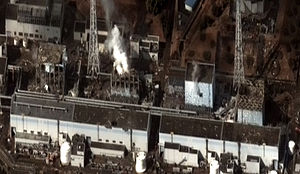| Part of the 2011 Tōhoku earthquake and tsunami | |
 The four damaged reactor buildings (from left: Units 4, 3, 2, and 1) on 16 March 2011. Hydrogen-air explosions in Units 1, 3, and 4 caused structural damage.[1] | |
| Date | 11 March 2011 |
|---|---|
| Location | Ōkuma and Futaba, Fukushima, Japan |
| Coordinates | 37°25′17″N 141°1′57″E / 37.42139°N 141.03250°E |
| Outcome | International Nuclear Event Scale Level 7 (major accident) |
| Deaths | 1 suspected from radiation (lung cancer, 4 years later).[2][3] |
| Non-fatal injuries | 6 with cancer or leukemia,[4] 16 with physical injuries due to hydrogen explosions.[5] 2 workers hospitalized with radiation burns[6][7] |
| Displaced | 164,000+ local residents |

RPV: reactor pressure vessel
DW: drywell enclosing reactor pressure vessel
WW: wetwell – torus-shaped all around the base enclosing steam suppression pool. Excess steam from the drywell enters the wetwell water pool via downcomer pipes.
SFP: spent fuel pool area
SCSW: secondary concrete shield wall
The Fukushima nuclear accident was a major nuclear accident at the Fukushima Daiichi nuclear power plant in Ōkuma, Fukushima, Japan which began on 11 March 2011. The proximate cause of the accident was the 2011 Tōhoku earthquake and tsunami, which resulted in electrical grid failure and damaged nearly all of the power plant's backup energy sources. The subsequent inability to sufficiently cool reactors after shutdown compromised containment and resulted in the release of radioactive contaminants into the surrounding environment.[8]: 56–58 The accident was rated seven (the maximum severity) on the International Nuclear Event Scale by Nuclear and Industrial Safety Agency, following a report by the JNES (Japan Nuclear Energy Safety Organization).[9][10] It is regarded as the worst nuclear incident since the Chernobyl disaster in 1986,[11] which was also rated a seven on the International Nuclear Event Scale.[12]
According to the United Nations Scientific Committee on the Effects of Atomic Radiation, "no adverse health effects among Fukushima residents have been documented that are directly attributable to radiation exposure from the Fukushima Daiichi nuclear plant accident".[13]: 106 [14] Insurance compensation was paid for one death from lung cancer, but this does not prove a causal relationship between radiation and the cancer.[2][3] Six other persons have been reported as having developed cancer or leukemia.[4] Two workers were hospitalized because of radiation burns,[6] and several other people sustained physical injuries as a consequence of the accident.[5]
Criticisms have been made about the public perception of radiological hazards resulting from accidents and the implementation of evacuations (similar to the Chernobyl nuclear accident), as they were accused of causing more harm than they prevented.[15] Following the accident, at least 164,000 residents of the surrounding area were permanently or temporarily displaced (either voluntarily or by evacuation order).[15][8]: 158 The displacements resulted in at least 51 deaths as well as stress and fear of radiological hazards.[16][17][18][19]
Investigations faulted lapses in safety and oversight, namely failures in risk assessment and evacuation planning.[8]: 61, 84–88 Controversy surrounds the disposal of treated wastewater once used to cool the reactor, resulting in numerous protests in neighboring countries.[20][21][22]
- ^ Cite error: The named reference
Aerial photos by Air Photo Service Co.was invoked but never defined (see the help page). - ^ a b Responses and Actions Taken by the Ministry of Health, Labour and Welfare of Japan on Radiation Protection at Works Relating to the Accident at TEPCO's Fukushima Daiichi Nuclear Power Plant 6th Edition (Fiscal Year of 2018) (PDF) (Report). Ministry of Health, Labour and Welfare. 31 January 2019. p. 13. Archived from the original (PDF) on 20 January 2022.
- ^ a b "Japan acknowledges first radiation death from nuclear plant hit by tsunami". ABC News. 6 September 2018. Retrieved 30 April 2019.
- ^ a b "Compensation claims from Fukushima plant work top 260 since 2011". The Japan Times. 31 October 2020. Retrieved 2 April 2021.
- ^ a b Cite error: The named reference
injurieswas invoked but never defined (see the help page). - ^ a b McCurry, Justin (24 March 2011). "Japan nuclear plant workers in hospital after radiation exposure". The Guardian. Retrieved 16 December 2013.
- ^ "Radiation-exposed workers to be treated at Chiba hospital". Kyodo News. 25 March 2011. Archived from the original on 17 February 2013. Retrieved 17 April 2011.
- ^ a b c d Cite error: The named reference
IAEA2015was invoked but never defined (see the help page). - ^ Cite error: The named reference
en20110412-4was invoked but never defined (see the help page). - ^ "Fukushima Nuclear Accident Update Log". www.iaea.org. 12 April 2011. Retrieved 6 September 2023.
- ^ "The Fukushima-Daiichi Nuclear Power Station Accident: An overview". United Nations Scientific Committee on the Effects of Atomic Radiation. Retrieved 9 May 2024.
- ^ "The international nuclear and radiological event scale" (PDF). www.iaea.org. IAEA. Retrieved 3 November 2024.
- ^ Cite error: The named reference
2020_21_Report_Vol.IIwas invoked but never defined (see the help page). - ^ Cite error: The named reference
:3was invoked but never defined (see the help page). - ^ a b Cite error: The named reference
:1was invoked but never defined (see the help page). - ^ Cite error: The named reference
:2was invoked but never defined (see the help page). - ^ Cite error: The named reference
spie78was invoked but never defined (see the help page). - ^ Cite error: The named reference
:11was invoked but never defined (see the help page). - ^ Cite error: The named reference
:12was invoked but never defined (see the help page). - ^ Cite error: The named reference
:5was invoked but never defined (see the help page). - ^ Cite error: The named reference
korwaterwas invoked but never defined (see the help page). - ^ Rodrigues, Charlene Anne (12 August 2023). "Fukushima nuclear disaster: Activists march against Tokyo's waste plan". BBC. Retrieved 20 June 2024.